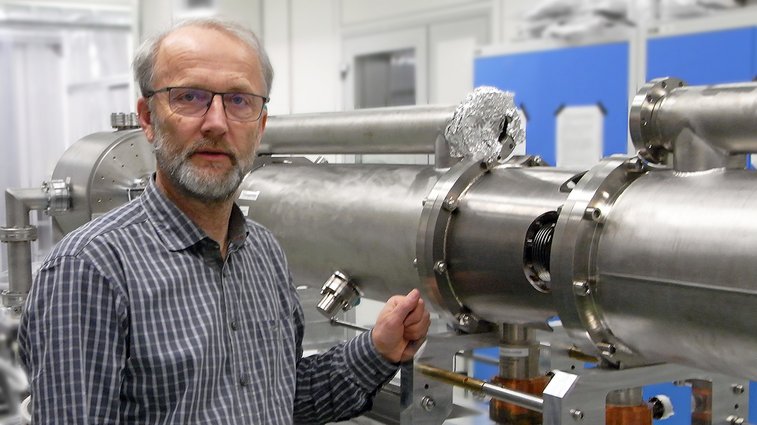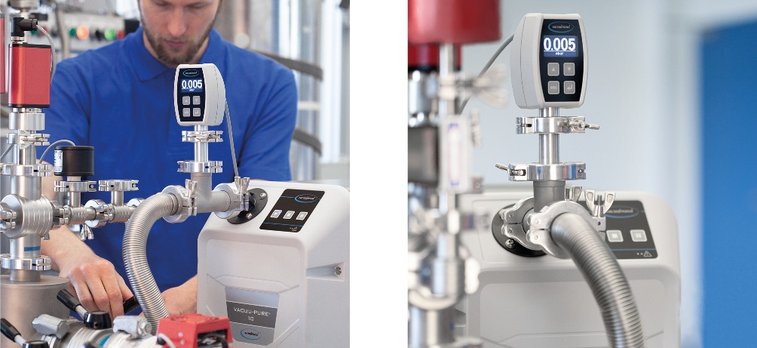
Michael Freitag at prepared assemblies of the electron linear accelerator ELBE of the Helmholtz-Zentrum Dresden-Rossendorf
© HZDR
Michael Freitag works at the ELBE linear accelerator of the Institute of Radiation Physics at the Helmholtz-Zentrum Dresden-Rossendorf (HZDR). As an operating engineer, he is responsible for the entire vacuum infrastructure and was delighted to be able to test the new 100% oil-free, abrasion-free VACUU·PURE® 10 screw pump from VACUUBRAND under real conditions. In the interview, he talks about the advantages of this new vacuum technology.
What research does the HZDR conduct?
Michael Freitag: The Helmholtz-Zentrum Dresden-Rossendorf is part of the Helmholtz Association of German Research Centres and strives for new knowledge to preserve and improve the foundations of our lives. To this end, research is conducted in the fields of energy, health and matter at the HZDR in Dresden and other locations.
The most complex device at HZDR is the superconducting electron linear accelerator ELBE (Electron Linac for beams with high Brilliance and low Emittance) with a total length of about 150 meters. It is internationally unique and represents a compact, accelerator-driven radiation source for particles and photons. Thanks to the ELBE accelerator, new materials for semiconductor technology and methods for cancer therapy can be explored for example.
To what extent does VACUU·PURE support the operation of the accelerator?
Michael Freitag: We were able to use the new screw pump initially in three different areas: Firstly, directly at the shutdown accelerator in the monitoring area to support the thermal insulation of the accelerator modules. Secondly, as a fore vacuum pump for turbomolecular pumps in various experimental setups to check parts of the accelerator before use. And thirdly, for the vacuum drying oven to bake out components of the accelerator.
What are the advantages of VACUU·PURE on the vacuum drying oven?
Michael Freitag: In preparation for operation, the components used in the accelerator are cleaned and baked out at 130 °C / 266° F in a vacuum drying oven. This ensures that we later obtain a clean vacuum without hydrocarbons.
Large quantities of steam are generated at the vacuum drying oven during drying. VACUU·PURE can easily handle these with its high condensate compatibility. Thanks to the integrated regeneration mode, it is back to ultimate vacuum much faster after drying than the scroll pumps used previously. This definitely saves us a lot of time.
What role does VACUU·PURE play for the accelerator's insulating vacuum?
Michael Freitag: The main acceleration takes place in the superconducting accelerator modules, which are cooled to about -271°C / -455,8° F with liquid helium. An insulating vacuum ensures thermal separation of these cryogenic regions from the environment.
During maintenance-related beam shutdowns, the accelerator modules are switched off and must be partially ventilated. At the end of a maintenance phase, we connected VACUU-PURE directly to the accelerator modules to achieve pre-evacuation of the insulating vacuum down to the deep fine vacuum (10-3 mbar). It was quite impressive how quickly VACUU·PURE evacuated the two cubic meter isolation volumes of the accelerator modules. Another big difference is that VACUU·PURE does not produce any abrasion on the suction side, unlike the scroll pumps we normally use, so we do not have to use any additional filters.
What is your experience with VACUU·PURE as a fore vacuum pump?
Michael Freitag: In preparatory test setups, for example, we check parts of the beam tube that will later be used in the accelerator. For these test setups, we tested the VACUU·PURE screw pump as a fore vacuum pump. Before the turbomolecular pumps were switched on, it first evacuated the tube parts to be examined from atmospheric pressure to deep fine vacuum. VACUU·PURE has proven to be an excellent fore vacuum pump for the various turbomolecular pumps used. Due to the very good ultimate vacuum, we are able to achieve a lower fore vacuum than with diaphragm pumps. This also improves the achievable ultimate vacuum of the turbomolecular pumps.
What is your overall impression of VACUU·PURE?

The VACUU·PURE® 10 screw pump for oil- and abrasion-free vacuum
Michael Freitag: In summary, I can say that the new VACUU·PURE screw pump offers exceptional performance in terms of ultimate vacuum, pumping speed and condensate compatibility. Another advantage for us is that no particles are generated thanks to the abrasion-free design. I also noticed that VACUU·PURE was surprisingly quiet in operation with our setup.
How is the cooperation with VACUUBRAND?
Michael Freitag: We have been using vacuum pumps from VACUUBRAND since the superconducting linear accelerator was built in 1998. In the meantime, there are around 50 pumps, mainly diaphragm pumps of the type MD 4 NT. Through many years of contact with the responsible colleagues in sales and service, the close cooperation has increased steadily. Through several visits to the VACUUBRAND headquarters in Wertheim, I have also been able to experience the continuous, positive development of the company over the years. I am always impressed by the cleanliness in the production areas, especially in machining. That's why we were happy to test the new VACUU·PURE screw pump. It was also well worth it for us, because we can speed up our processes with this new and versatile technology.
We would like to thank Mr. Michael Freitag and the Helmholtz-Zentrum Dresden-Rossendorf for the interview.
Information on the ELBE radiation source
The ELBE radiation source at the HZDR provides suitable types of beams for researchers in many disciplines to perform various experiments. To generate these types of beams, electrons are first accelerated to energies of up to 40 MeV. This corresponds to a velocity of 99.992 % of the vacuum light velocity. To avoid collisions with air molecules, it is therefore also essential that an ultra-high vacuum of up to 10-10 mbar prevails in the beam tube. Then, in addition to electrons, neutrons and positrons are also available for experiments. Electromagnetic radiation, such as the infrared radiation of a free-electron laser, can also be used.
More information at www.hzdr.de
